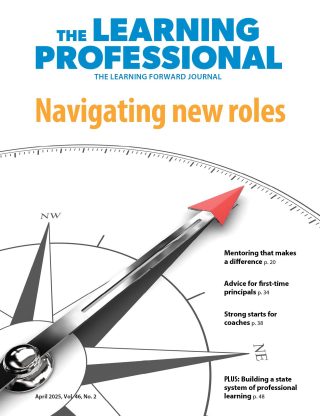When I told a colleague we were focusing our fall issue of The Learning Professional on how leaders can thrive in stressful times, she astutely asked, “When is working in schools not stressful?” Constant stress notwithstanding, she recognized what we all do: School and system leadership is especially challenging right now.
Even as we try to regain some semblance of normalcy, education leaders are finding themselves in situations unimaginable even a year ago. Many of last year’s challenges remain, but they are compounded by new ones.
Amid staffing shortages, principals and superintendents are substituting in classrooms and filling in for cafeteria workers and bus drivers. They are working to accelerate students’ learning while dealing with ongoing absences due to illness and quarantine. Many are also caught in heated debates over whether and how to implement COVID-19 mitigation measures. Meanwhile, fear, loss, and trauma are still very real.
As they always do, school and system leaders are rising to the challenges and steering their teams with creativity, commitment, and compassion. This issue is dedicated to sharing how principals, superintendents, coaches, and others are shining the light of leadership in these dark times.
This issue is dedicated to sharing how #principals, superintendents, coaches, & others are shining the light of leadership in these dark times. #TheLearningPro Share on XIn this issue, we highlight lessons about what’s working — and not working — and what kinds of support leaders need to keep going strong. The authors’ insights can be applied in whatever space and whatever role you work, whether at the classroom, school, district, state, province, or national level.
Leaders who succeed in stressful times approach complexity with clarity, the authors show. They step back and see the big picture, even while addressing the specific details and emergent needs of daily life in schools, to pave a clear path through tangled terrain. That starts with a coherent plan for professional learning.
''Leaders who succeed in stressful times approach complexity with clarity.'' #TheLearningPro Share on XArticles explain how a districtwide professional learning plan connects educators and initiatives across levels (see the article “No more random acts of professional learning”), how leaders can create an ecosystem of learning (see the article “Leaders play key roles in the professional learning ecosystem”), how high-quality instructional materials can shape a systemwide plan (see the article “New curriculum demands new support”), and more.
Social and emotional support is also high on the list of leadership priorities. Authors help us all remember to keep extending the “grace and space” we heard so much about last year, both to our colleagues and ourselves. They explain why leaders should pay attention to teachers’ well-being, sense of purpose, and feelings of burnout (see the article “Lead with social and emotional support”). They describe concrete strategies for supporting teachers and other staff with compassionate leadership (see the article “As crises mount, respond with compassionate leadership”). And they explain how social support is a fundamental part of responding to crises, including racist incidents (see the article “Meet racist incidents head-on with a crisis plan”).
Leaders need social and emotional support, too, especially in times like these. Authors recommend strategies for leaders to cultivate their own resilience (see the article “Lead with social and emotional support”), hone their roles as learning leaders (see the article “How to prepare leaders for a crisis”), connect with peers through cross-district networks (see the article “Professional learning for a virtual world”), and keep growing as they keep going (see the article “What it takes to become a learning system”).
School and system leaders have an undeniable impact on schools and students — and the pandemic is having an undeniable impact on leaders. For example, as we highlight in this issue’s At a Glance infographic (see the article “The case for investing in principals’ learning”), national surveys show that 62% of principals reported lower morale in December 2020 than before the pandemic and 45% of U.S. principals reported that pandemic working conditions are accelerating their plans to leave the profession.
While we can’t change the stresses leaders and other educators are facing, we hope we can help you navigate them with thoughtful, practical, and diverse strategies so you can keep shining your light for schools and students.

Suzanne Bouffard is senior vice president of communications and publications at Learning Forward. She is the editor of The Learning Professional, Learning Forward’s flagship publication. She also contributes to the Learning Forward blog and webinars. With a background in child development, she has a passion for making research and best practices accessible to educators, policymakers, and families. She has written for many national publications including The New York Times and the Atlantic, and previously worked as a writer and researcher at the Harvard Graduate School of Education. She has a Ph.D. in developmental psychology from Duke University and a B.A. from Wesleyan University. She loves working with authors to help them develop their ideas and voices for publication.
Recent Issues
LEARNING DESIGNS
February 2025
How we learn influences what we learn. This issue shares essential...
BUILDING BRIDGES
December 2024
Students benefit when educators bridge the continuum of professional...
CURRICULUM-BASED PROFESSIONAL LEARNING
October 2024
High-quality curriculum requires skilled educators to put it into...
LEARNING TO PIVOT
August 2024
Sometimes new information and situations call for major change. This issue...












